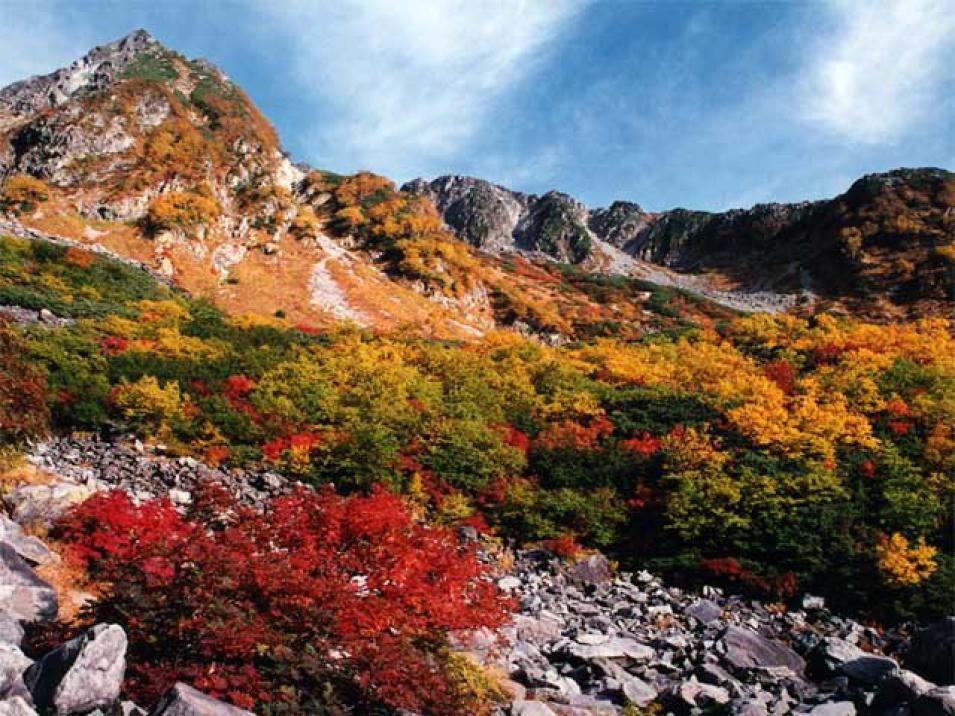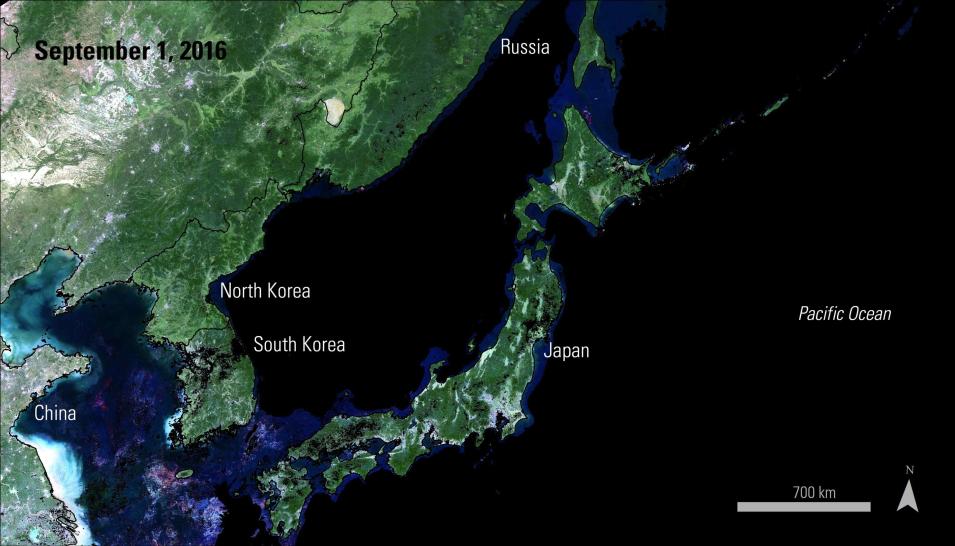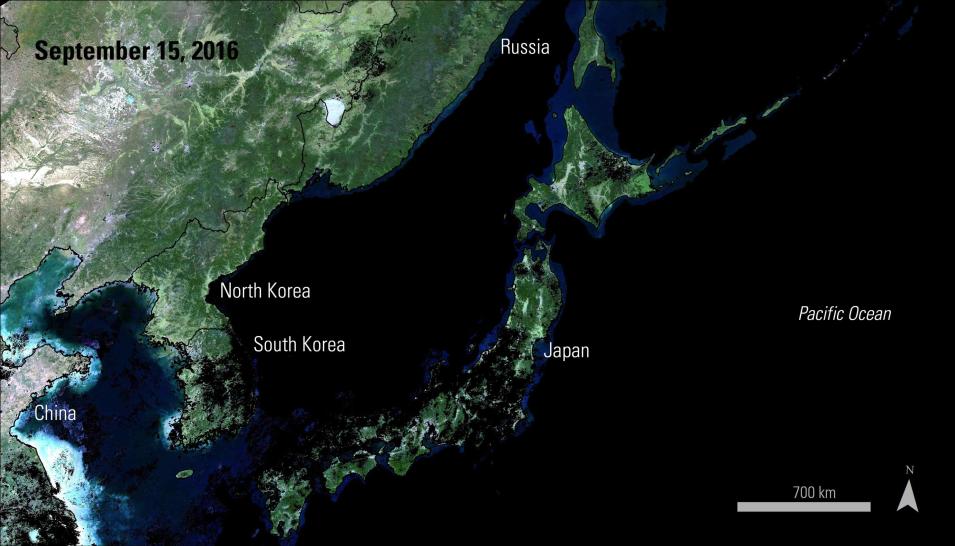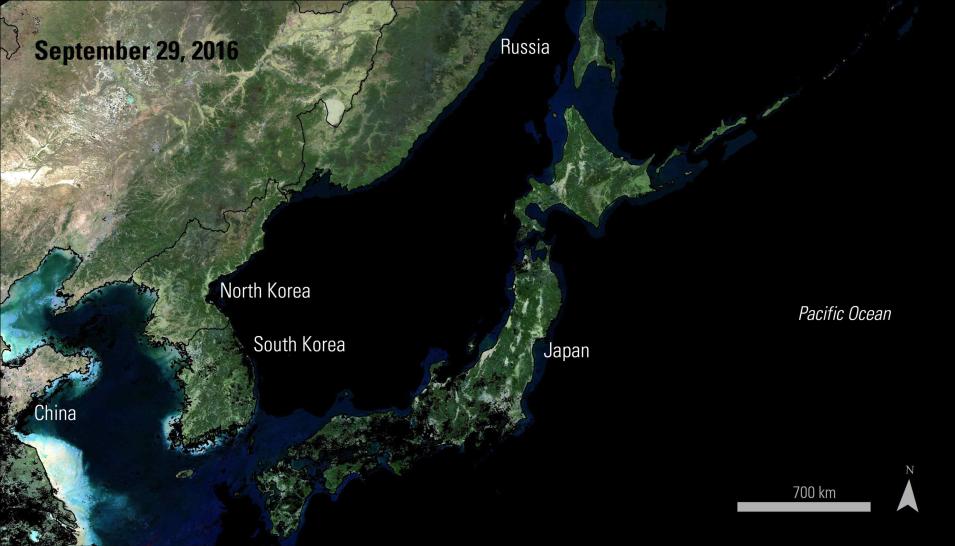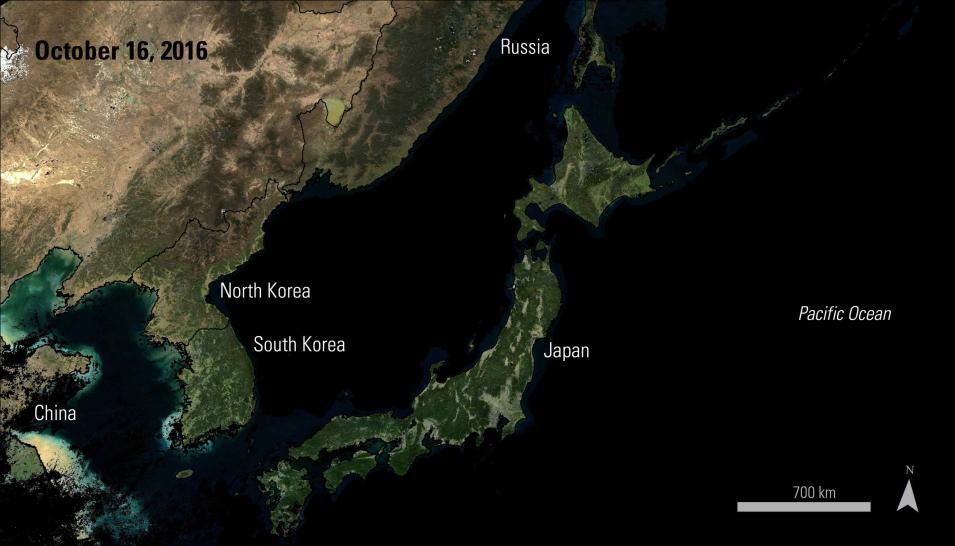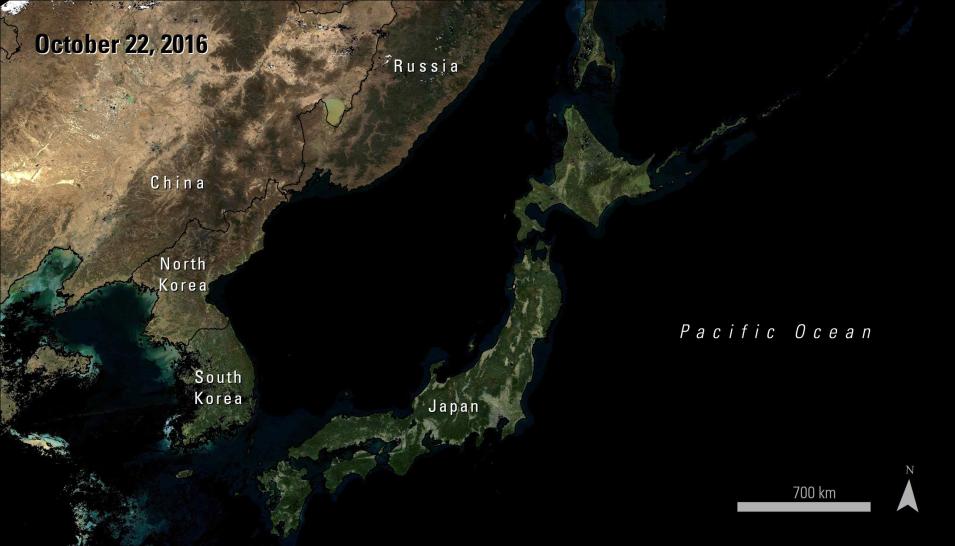References
Article References
Archetti, M., Döring, T.F., Hagen, S.B., Hughes, N.M., Leather, S.R., Lee, D.W., Lev-Yadun, S., Manetas, Y., Ougham, H.J., Schaberg, P.G., and Thomas, H., 2009, Unravelling the evolution of autumn colours—An interdisciplinary approach: Trends in Ecology & Evolution, v. 24, no. 3, p. 166-173. doi:10.1016/j.tree.2008.10.006
Lim, P.O., Kim, H.J. and Nam, H.G., 2007, Leaf senescence: Annual Review of Plant Biology, v. 58, p. 115–136. doi:10.1146/annurev.arplant.57.032905.105316
USDA Forest Service, 2011, Why leaves change color, accessed Sept. 22, 2016.
USDA National Arboretum, 2011, The science of color in autumn leaves, accessed Sept. 22, 2016.
Image References
Boundary source: Global Administrative Unit Layers (GAUL) dataset, implemented by FAO within the CountrySTAT and Agricultural Market Information System (AMIS) projects
Sept. 1, 2016, MODIS Image Granule IDs
- MCD43A4.A2016245.h26v03.006.2016256231611.hdf
- MCD43A4.A2016245.h26v04.006.2016256231442.hdf
- MCD43A4.A2016245.h26v05.006.2016256231337.hdf
- MCD43A4.A2016245.h27v03.006.2016256231508.hdf
- MCD43A4.A2016245.h27v04.006.2016256231340.hdf
- MCD43A4.A2016245.h27v05.006.2016256231343.hdf
- MCD43A4.A2016245.h28v04.006.2016256231500.hdf
- MCD43A4.A2016245.h28v05.006.2016256231455.hdf
- MCD43A4.A2016245.h29v05.006.2016256231652.hdf
Sept. 15, 2016, MODIS Image Granule IDs
- MCD43A4.A2016259.h26v03.006.2016272164754.hdf
- MCD43A4.A2016259.h26v04.006.2016272170700.hdf
- MCD43A4.A2016259.h26v05.006.2016272165810.hdf
- MCD43A4.A2016259.h27v03.006.2016272161615.hdf
- MCD43A4.A2016259.h27v04.006.2016272164742.hdf
- MCD43A4.A2016259.h27v05.006.2016272165854.hdf
- MCD43A4.A2016259.h28v04.006.2016272161700.hdf
- MCD43A4.A2016259.h28v05.006.2016272164758.hdf
- MCD43A4.A2016259.h29v05.006.2016272161719.hdf
Sept. 29, 2016, MODIS Image Granule IDs
- MCD43A4.A2016273.h26v03.006.2016284145124.hdf
- MCD43A4.A2016273.h26v04.006.2016284145155.hdf
- MCD43A4.A2016273.h26v05.006.2016284145143.hdf
- MCD43A4.A2016273.h27v03.006.2016284145234.hd
- MCD43A4.A2016273.h27v04.006.2016284145229.hdf
- MCD43A4.A2016273.h27v05.006.2016284145228.hdf
- MCD43A4.A2016273.h28v04.006.2016284145303.hdf
- MCD43A4.A2016273.h28v05.006.2016284145302.hdf
- MCD43A4.A2016273.h29v05.006.2016284145335.hdf
Oct. 16, 2016, MODIS Image Granule IDs
- MCD43A4.A2016289.h26v03.006.2016302022806.hdf
- MCD43A4.A2016289.h26v04.006.2016302023357.hdf
- MCD43A4.A2016289.h26v05.006.2016302022201.hdf
- MCD43A4.A2016289.h27v03.006.2016302022043.hdf
- MCD43A4.A2016289.h27v04.006.2016302022303.hdf
- MCD43A4.A2016289.h27v05.006.2016302022302.hdf
- MCD43A4.A2016289.h28v04.006.2016302021948.hdf
- MCD43A4.A2016289.h28v05.006.2016302022737.hdf
- MCD43A4.A2016289.h29v05.006.2016302022145.hdf
Oct. 22, 2016, MODIS Image Granule IDs
- MCD43A4.A2016296.h26v03.006.2016305073504.hdf
- MCD43A4.A2016296.h26v04.006.2016305073557.hdf
- MCD43A4.A2016296.h26v05.006.2016305073300.hdf
- MCD43A4.A2016296.h27v03.006.2016305073645.hdf
- MCD43A4.A2016296.h27v04.006.2016305073212.hdf
- MCD43A4.A2016296.h27v05.006.2016305073253.hdf
- MCD43A4.A2016296.h28v04.006.2016305073643.hdf
- MCD43A4.A2016296.h28v05.006.2016305073247.hdf
- MCD43A4.A2016296.h29v05.006.2016305073435.hdf
Citation
Schaaf, C., Wang, Z. (2015). MCD43A4 MODIS/Terra+Aqua BRDF/Albedo Nadir BRDF Adjusted Ref Daily L3 Global - 500m V006 [Data set]. NASA EOSDIS Land Processes Distributed Active Archive Center. Accessed 2025-05-29 from https://doi.org/10.5067/MODIS/MCD43A4.006.
